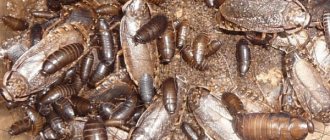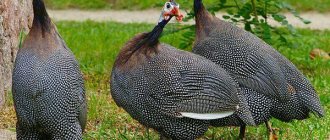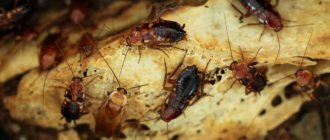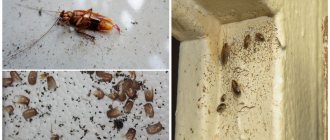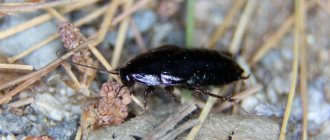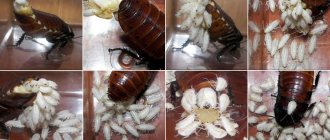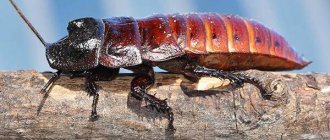Marble cockroaches
There are different types of cockroaches. That's why we treat them differently too. We have been fiercely fighting some for centuries, trying to expel them forever from our environment, while on others, on the contrary, we are ready to spend money, time, and effort in order to multiply them. In particular, we are talking about the so-called “marbled cockroaches” (Nauphoeta Cinerea).
Appearance, lifestyle
Marbled cockroaches are small, fast, brown, exotic, tropical insects native to the Caribbean.
When they are adults their size reaches up to 30 mm. Although they have wings, they cannot fly. You can meet them in numerous photos of “cockroach breeders”
Why breed marbled cockroaches?
Marbled cockroaches are feeding insects
At first glance it sounds strange, but there are reasons for this. Ash cockroaches are considered the best solution when you need to provide fresh, high-calorie food for an extensive home collection of reptiles and amphibians, but often there is no time or opportunity to buy it. Then one of the rational solutions would be to breed insects at home.
Unsightly to us humans, the cockroach, lizards, frogs, toads, spiders, primates, amphibians, spiders, and snakes are very much valued as dietary and low-fat food. It is grown specifically for feeding animals with liver problems. “Live food” itself is not picky about food, eats almost any food and at the same time reproduces quickly in captivity. Moreover, it is inexpensive. The temperature range for life activity is wide, and its upper limit can even exceed 30 degrees.
About nutrition
Let's talk about how the insect feeds.
As mentioned above, ashen cockroaches happily eat everything they come across on the road: cheese, bread, vegetables, fruits. In the wild, they eat smaller insects. At home, marbled cockroaches are raised to feed other animals, which means they must have nutritional value. The owners feed them:
- Protein products: dry food for fish and cats, eggs, low-fat cottage cheese, bloodworms, leftover meat dishes.
- Cereals, feed, bran.
- Bakery products.
- Cabbage, lettuce leaves, beets.
- Apples and pears.
- Flowers and herbs.
You should not give bananas, tomatoes, nuts, lard, or cheese to insects. Carbohydrate and protein foods should not be mixed. For these purposes you will need two feeders. The feed is renewed after three or four days.
If you do not adhere to these rules, then the naufets may die prematurely. No matter how omnivorous they are, there are foods that will harm them.
Breeding marbled cockroaches
Let's look at what is needed to maintain marbles.
Insectarium
You can choose a plastic box or a glass aquarium as a “house” for mustaches. Its top is smeared with Vaseline so that the inhabitants do not escape when the lid is opened. The lid (which should close tightly) should have plenty of ventilation holes. If you decide to cut a hole and insert the mesh, then keep in mind that you will then need to pay special attention to covering the top of the aquarium with Vaseline, as the mesh can be easily chewed through by marbles. Try to choose a box that meets the following conditions:
- Height is more than 20 cm.
- The walls are opaque.
- 1/3 of the lid consists of mesh.
- The presence of cracks or cracks is unacceptable (unless, of course, you want to start breeding marbles somewhere in the kitchen under the cabinets).
The bottom of the insectarium is lined with vermiculite about 1.5 cm thick. The egg cells are cut into four equal parts and placed vertically along the walls.
Tip: the volume of the “dwelling” is calculated depending on the size of the colony - 1 liter per 1 individual.
Feed and water
Place a bowl for food and water. Be sure to add vermiculite to the water bowl, leaving only half a centimeter to the edge. If you simply pour water into a bowl, cockroaches can drown in it. You can also put a regular kitchen sponge at the bottom of the water bowl. Although marble fish are quite unpretentious in food, they also need nutrients - a lot of fiber and protein supplements (egg whites, gammarus, dried shrimp).
Please note: if you are feeding fruits and vegetables that contain enough juice, you can add water less often.
As has already been said, marbled moths are not capricious creatures, and when there is not enough food, and their number increases, they can switch to wood and cardboard, if they are available in the insectarium. Considering that you are preparing them as food for other pets, when the colony increases (and baleen breeds very quickly), you will need to carefully monitor that there is enough food.
Place for insectarium
Before you start a colony to settle into their new home, you need to determine the best place for an aquarium or box. They say that the homeland of the marbled plant is North Africa. However, now it is so widespread throughout the world that it is difficult to say for sure. But this species of baleen still prefers warm temperatures - it is best that in the insectarium it is kept from 20 to 30 degrees with air humidity of about 60%. To achieve this, the angle of the insectarium itself must be warm (near the battery), or a special lamp must be installed above the box.
Attention: if a cockroach escapes from its house, it will take root perfectly in an apartment, so be vigilant!
Care
Marbled cockroaches, which are quite easy to keep, will still require minimal care. As soon as the soil becomes contaminated, it must be replaced to prevent the appearance of mites and bacteria. If there is no vermiculite to replace the soil, then it can be replaced with coconut shavings, sawdust (not pine), and dry cat food. To maintain the required humidity, it is enough to spray warm water from a spray bottle several times weekly.
Reproduction
During the development of embryos, the bag with the eggs is in the female; the female can expose them to air out. After the hatching of the offspring, the female experiences a short-term manifestation of maternal instinct - she protects her cubs and does not allow other members of the colony to approach them. Pregnancy lasts 2-4 weeks. At one time, the female gives birth to 10 to 30 dark brown larvae. It will take 4-8 months for a larva to become an adult cockroach; this period may be shorter if the temperature in the “house” is higher.
In the video below you can see what life looks like in the cockroach kingdom of marbles. And if you want to learn about other types of these insects, including very exotic ones, read the article: Appearance, photo and structure of cockroaches.
How does reproduction occur and how quickly?
Cockroaches reproduce very quickly, regardless of external conditions. However, they need to build a special insectorium from which the insects will not be able to escape.
It should be glass, quite tall and have a tight lid. Small ventilation holes are needed in the walls of the dwelling for sufficient air circulation, and the floor of the container is covered with vermiculite and covers made of paper egg trays are installed.
What conditions are required?
For reproduction, it is necessary to plant 1-2 males and 2-3 females separately. Mating occurs quickly, and immediately an ootheca begins to develop in the female’s body, into which all the fertilized eggs are placed. The temperature in the insectarium should be between +25C and +27C, and the air humidity should be at least 60%.
To reduce the reproduction rate, it is enough to slightly reduce the temperature. This way you can control the cockroach population.
How does mating happen?
During puberty, the female’s body begins to secrete a specific secretion that attracts males with its smell. During the mating process, males help themselves with the help of long wings, and the fertilization procedure itself takes only 1-2 minutes.
As soon as the male's seminal fluid enters the female's reproductive chamber, fertilization of all the eggs located there occurs. At the same time, a special gland begins to produce a sticky liquid, from which an ootheca is formed for the eggs.
Fertility of females and how to distinguish them from males
Females are much larger than males, and their wings are smaller and shorter. At one time, the female lays up to 30 eggs in a capsule, and throughout her life she is capable of producing offspring up to 4-6 times.
Where do cockroaches make their nests?
Ordinary domestic parasites living in apartments try to build nests in the most secluded and inaccessible places. Marbleds do not have this opportunity, because they live in closed insectariums.
For this purpose, a separate large (well-closed) container is prepared for newborn nymphs, where they will grow and develop. What to feed marbled cockroaches so that they multiply and grow quickly? These are omnivorous insects, but it is better to give them food rich in protein and fiber.
Breeding the population
The marbled cockroach is active at night. To speed up the reproduction process, the house is placed in a dark place. It is rational to breed food creatures from 50 individuals.
It is necessary to selectively feed marbled fish to snakes, lizards, scorpions and other inhabitants of the terrarium. First males until there are 3 left, then females. To quickly replenish the genus, 3 individuals of each sex are enough.
A new generation of larvae is born after 2 weeks. Nymphs molt periodically and increase in size. Each time they look more and more like imagoes. The ability to fertilize appears after 1 month of a carefree life. Marbleds feel great in artificial conditions and reproduce quickly. To prevent the population from weakening, several females and males from another colony are periodically added to the insectarium.
The marbled cockroach sacrifices itself for the sake of adequate nutrition for other animals that have liver problems. They buy food insects specially or start breeding them themselves.
How to care?
If they try to get the Prussians out of the house, the Madagascar cockroaches are given all the favorable conditions for a normal existence. Pets require a spacious container.
Deep bedding is not provided for baby cockroaches. You can add a little oatmeal for them. For adults, it is recommended to sprinkle coconut shavings up to 3 cm deep.
Recommended: Is there a white Madagascar cockroach?
Cockroaches need warmth and high humidity. Without water they will die on the 5th day. To humidify the air, insects are sprayed with water. For drinking, place a sponge in the terrarium, which is periodically moistened. A separate container with water is not installed so that the individuals do not drown.
To feed Madagascar cockroaches, they need food not only of plant origin, but also animal protein. In nature, they eat leaves, grass, fallen fruits, and berries. Sometimes they feed on carrion. At home, pets are offered fish food and krill as protein food.
Insects do not smell, but to prevent fungus or parasites from developing in the terrarium, it is recommended to change the top layer of litter once a week if it is thick, or completely remove it if the depth of the floor material is shallow.
For the cubs, the same regime is maintained as for adult cockroaches. They eat little food, but they are also given vegetables, fruits, grass, and krill.
Feeders must be washed and leftover food thrown away. Otherwise, the contents of the container may rot or sour, which cannot be allowed.
When kept comfortably, cockroaches grow quickly and molt. At the age of one year they give birth to offspring. Keepers need to correctly determine the sex of insects and create conditions for the normal development of the female’s pregnancy.
Intrauterine development of the cubs will proceed in a short time if the terrarium is warm and high humidity is maintained.
Food preferences
Marbled cockroaches are omnivorous creatures; insects feed on almost absolutely everything. In the wild, they feed on plant leaves, vegetables, fruits, carrion, rot, and eat small insects, worms, and larvae.
There are no difficulties with what to feed marbled cockroaches in a home insectarium. They happily eat eggs, small shrimp, oatmeal, corn flour, porridge, vegetables, fruits, cottage cheese, milk and much more. It is not recommended to give banana, cabbage, tomatoes, as these products are difficult to digest. The marbled cockroach happily eats cat and dog food.
We suggest you read: Fighting bedbugs and cockroaches in the apartment
Feed the insects thoroughly - shrimp, small insects, using tweezers, at least 2 times a week. Food supplies should be enough for 1.5 hours. After this, residents of the insectarium are offered additional feeding in the form of vegetables, fruits, milk, eggs, etc. Dry food is laid out in feeders.
What explains the persistence of these insects?
Cockroaches are amazingly resilient insects. They can exist even without a head. Their viability is explained by the fact that:
- Having lost its head, the parasite continues to live fully for a certain time. Typically, the life expectancy of a headless cockroach does not exceed 7 days. Such individuals usually die from thirst.
- Representatives of the cockroach order can hold their breath for 40 minutes.
- Insects run very fast, covering almost 5 km in an hour. Considering the length of their legs, this is a lot of speed.
- For a full-fledged existence, these mustachioed creatures only need to eat once a month and drink water once a week.
- Red, black and other species of the cockroach family, which have developed jaws, are omnivorous, so they can find food anywhere.
- Thanks to the presence of wings, males are able to travel short distances through the air in search of food, or, more precisely, to jump.
- Parasites are almost impossible to catch. Thanks to the hairs on their paws, they feel the slightest vibration in the air, and rushing to their heels, constantly change the trajectory of movement (up to 25 times per second).
- These representatives of the animal kingdom are able to withstand low temperatures down to 5 degrees below zero.
- Unlike most other insects - beetles, butterflies, ants - cockroaches are not afraid of radiation. Radiation is not capable of destroying them due to slow cell division.
Features of care
To ensure that marbled cockroaches do not die prematurely, several rules must be followed.
- Remember to keep an eye on the ratio of females to males in the group.
- Feed the males first.
- At least once a month, place the adults in a different container. They are the main colony. Small cockroaches should be kept separately. If you do everything according to the rules, then after a while you will need not one, but several containers. Each age and size has its own territory.
- Colonies should be renewed once a year. You can add individuals from another colony to the main family. If the family does not renew itself, fertility will decrease and the young will be weak.
Features of Prussians that help them survive in various conditions
- When cockroaches, a male and a female, mate for the first time, the gametes of the male are stored in the body of the latter. This allows her to produce offspring independently and not depend on the “male” half. That is, in her entire life it is enough for her to meet a male once in order to lay eggs herself in the future.
- Life without a head. If a barbel's head is torn off, the body continues to function normally and continue to live, only water and food do not enter it, as a result of which it dies from hunger.
- Don't breathe for 40 minutes. Scientists have hypothesized that this helped them survive in ancient times, when the atmosphere on Earth was underdeveloped.
- Pests are lazy. They don't move 75% of their life.
- They move quickly. Despite their small limbs, cockroaches can run at speeds of 5 km/hour.
- Eat food once every 30 days. They eat any food thanks to their powerful jaws.
- Difficult to catch. When a Prussian runs away from a person, it changes its trajectory several times.
- Don't be afraid of radiation. Because of this, they are able to survive an atomic explosion. This feature is achieved due to slow cell division.
- Protected wings. This allows them not to lose mobility and fly short distances.
Interaction with people
This species reproduces easily in captivity and is therefore often used as live food for other invertebrates such as tarantulas and mantises, as well as small lizards.
Also sometimes used as a laboratory model for research purposes.
Advantages:
- Easy to keep and breed.
- They live up to a year.
- As suitable for reptiles and amphibians as other food.
- Ideal for geckos, skinks and frogs.
- Unlike crickets, they can be said to “bloom when forgotten.”
Are marbled cockroaches dangerous for humans?
If your cockroaches escaped from the insectarium, then the harm from them is the same as from ordinary cockroaches. Theoretically, they cannot bite, but they will carry infectious diseases. They will also poison your life, taking over your territory and running your kitchen.
